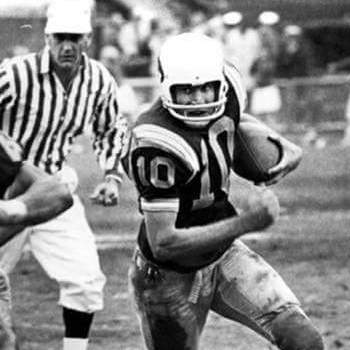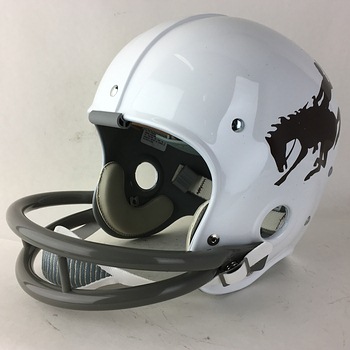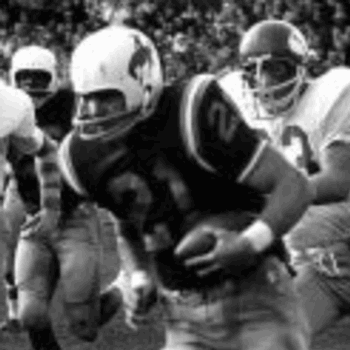When more than 10,000 Wyoming Cowboys fans
made the trip to the 1968 Sugar Bowl, it became a
celebratory nod to the 1967 squad that finished with a 10 –
0 record and number six national ranking. In every way
possible it was a coming out party, a reflection of the
realization that Wyoming, somewhat isolated and usually no
more than a blip on the national consciousness of college
football, had truly arrived as a major power. Wyoming
diehards had waited a long time for the moment they could go
to a major bowl game and claim that their team was either on
par or superior to a major conference opponent and 1967 was
that season. Although there were individual stars, Wyoming
had made the ultimate team effort to earn the national
spotlight as they prepared to take on always dangerous
LSU. The 5 – 0 contingent cracked the top ten on October 16
although detractors noted that the latest victory over
Wichita State reflected a perceived lackluster schedule. At
the conclusion of their regular season, they stood at 10 – 0
– 0 and their stifling defense was strong enough to get the
assignment to the prestigious Sugar Bowl against a solid 6 –
3 - 1 LSU team. The ascension of Wyoming football from what
was considered to be a backwater outpost began under the
aegis of Bowden Wyatt, a mid-1930s College Football Hall of
Fame player at the University of Tennessee who took the head
coach position for Wyoming in 1947. He reeled off an
impressive 39 – 17 – 1 record through 1952 before moving on
to Arkansas and then his alma mater. Phil Dickens came over
from small Wofford College and elevated the Cowboys record
to a fine 29 – 11 – 1 with an undefeated 10 – 0 mark in
1956. Dickens left for Indiana University but the Cowboys
continued to attract sterling coaching talent with the
arrival of Michigan State assistant Bob Devaney for the ’57
season [ see HELMET NEWS/REFLECTIONS http://www.helmethut.com/Features/Dr.Ken140.html
, June, July, August 2015] who brought defensive line coach
Lloyd Eaton with him. Eaton
was a disciplined individual who expected perfection from
what were generally undersized defensive linemen under his
tutelage. He taught specific techniques that were considered
to be new and innovative and Wyoming consistently had tough
and effective defensive fronts. Devaney continued the
success of his coaching predecessors in Laramie, posting a
35 – 10 – 5 record and winning or tying for the Skyline
Conference title in four of his five seasons. He departed
for Nebraska where he enjoyed a College Football Hall of
Fame and National Championship career, which moved Eaton up
to the head coaching slot. As head coach at Alma (Michigan)
College, Eaton had proven his mettle garnering forty
victories in seven seasons and then concluded a 7 – 0 – 1
mark at Northern Michigan before moving to Wyoming as an
assistant under Devaney. Eaton learned well under his
mentor, becoming a terrific recruiter who sent his
assistants far and wide to reel in talent. The ’67 team had
better representation from the Northeastern U.S. with only
eight Wyoming residents on the roster.
|
 |
 |
With the formation of the Western Athletic
Conference and its entry into a much more competitive group
of universities, Eaton forged a five win and then three
consecutive six win seasons before hitting his stride with
‘66’s ten victories and a second consecutive ten win mark in
1967. Despite the presence of bigger name players like the
Chargers number one draft choice, defensive tackle Ron
“Pedro” Billingsley, safety Paul Toscano demonstrated
excellent leadership skills on a 1966 defense that led the
nation against the rush allowing but 38.5 yards per game,
was number six against scoring, and ranked fifth in total
defense. His 165 yards on six interception returns set a new
school record. The offense was solid with Rick Egloff the
quarterback, surrounded by running backs Jim Kiick and
sophomores Dave Hampton, Gene Huey, and two-way performer
Vic Washington. Washington finished the season as the
country’s top punt returner, Jerry DePoyster’s seventy-one
points led the nation in placekicking points, but it was the
defense that stole the show. Their 28 – 20 Sun Bowl victory
over Florida State almost made up for the infamous “Bounce
Pass” loss to Colorado State, the only negative on the
season’s slate. Entering the ’67 season, opponents expected
more of the same; a lot of defense and a brutal running
attack although Egloff’s graduation to a few games in the
CFL left a hole at quarterback. With his Second Team All WAC
safety the best option, Eaton had Toscano take the helm and
he was outstanding, piloting the squad to a 10 – 0 record,
the only major college team to go undefeated, and the Sugar
Bowl berth.
Toscano had been a
three-sport team captain at Clarkstown High School in
Rockland County, a far suburb of New York City and best
known as a record setting basketball player. His All County
work at center field relegated his Honorable Mention All
County quarterbacking to the least appreciated of his high
school athletic talents yet he attended Wyoming on a
football scholarship, one of a relatively large number of
Eastern recruits. He was the team’s most improved player as
a junior, earning Second Team All Conference notice and
Eaton tapped his vast athletic ability and leadership skills
when placing him at quarterback for the ’67 season.
Toscano’s response was1915 total yards of offense, the
nation’s leader in touchdown passes, eleven WAC records, the
conference MVP and Player of the Year Awards, UPI Rocky
Mountain Region Player of the Year winner, and a finisher in
the Heisman Trophy balloting. Despite the presence of Kiick
who went on to an excellent professional career with the
Dolphins and Broncos, Dave Hampton who was a solid running
back with the Packers, Falcons, and Eagles, Gene Huey who
swung between record setting wingback receiver and defensive
back, and Vic Washington who also played a dual offensive
and defensive role, it was Toscano who carried the team to
the dizzying heights of 1967.
Their bowl game against LSU in an era of
limited bowl games was truly ground-breaking for the
Cowboys. One of the four major New Years Day Bowls, a
national television audience, and the recognition as the
only undefeated major college team of the season made for
well deserved exposure. The game, played in a quagmire,
reflected typical Cowboys style in the first half as the
suffocating defense capped the LSU offense and Toscano led
his team to a Jim Kiick touchdown plunge after a grinding
eighty yard drive as the second quarter began. The 13 – 0
halftime lead would not hold up however as the potent Bayou
Tigers fought back to win 20 – 13 with Wyoming stranded on
the LSU five yard line as the game ended. Though just
missing out on a perfect season, the point was made; Toscano
and a handful of supposedly second-tier players had
performed in disciplined, team-oriented lockstep to become a
national power. The reward was the drafting of a number of
players. Kicker DePoyster was a second rounder of the
Raiders who enjoyed a few years in the NFL despite having
his career interrupted by two years of military service.
Offensive guard Mike LaHood like DePoyster was a second
round pick, spending time with the Rams, Cardinals, and in
the CFL despite also having his career disrupted by military
service before returning to his hometown of Peoria, IL to
serve as a labor union officer. Jim Kiick and All American
defensive tackle Mike Dirks had solid pro careers with Dirks
an excellent performer for the Eagles for four seasons
before playing another seven in the CFL. Toscano was a late
draft pick of the Oilers but did not make the cut, later
returning to his Clarkstown High School alma mater where he
became their highly successful, beloved, and long-time
basketball coach since the 1976-’77 season.
|
 |
 |
The Wyoming helmet was reflective of Eaton’s
Wyoming teams, with the brown “Cowboy Joe” logo on both
sides of a white shell. Eaton allowed small light brown
player identification numerals on the rear but as might be
expected, the helmet stated “function” and “not fancy.” The
Wyoming logo depicting a cowboy on a bucking horse has been
part of Wyoming lore since 1918 when the image was used on
the uniforms of a Wyoming infantry unit and it was adopted
by the University’s athletic department in the early 1920s.
It pays homage to National Cowboy and Rodeo Halls of Fame
horse Steamboat, a legendary Wyoming born bucking bronco.
There has been discussion related to the rider, with some
insisting the image was taken from a 1903 photograph of
Steamboat and cowboy Guy Holt, and others believing it is
Clayton Danks, both famous, award winning riders who had a
history with Steamboat. The official symbol for the state
“represents the toughness and never-say-die spirit that is
Wyoming.” Toscano’s Riddell RK 2 helmet featured the BD9 two
bar mask which was typical for backs of his era. The clearly
stated and to-the-point Wyoming helmet that Toscano and his
teammates so proudly wore immediately identifies Wyoming and
Wyoming football. The team turned in another WAC winning
season in 1968 but racial discord led to the suspension of
“The Black 14” in 1969 in what was an increasingly difficult
process of communication among coaches and groups of
discordant athletes in the late 1960s. Wyoming reeled off
six consecutive wins to open the season, and then lost four
after the suspensions. It was worse in ’70 as the Cowboys
toppled from the heights of the nation’s best teams to a 1 –
9 mark which led to the resignation of Coach Eaton. Paul
Toscano and the 1967 team proved to be the high-water mark
for the Wyoming program, a level they have yet to approach
since.

